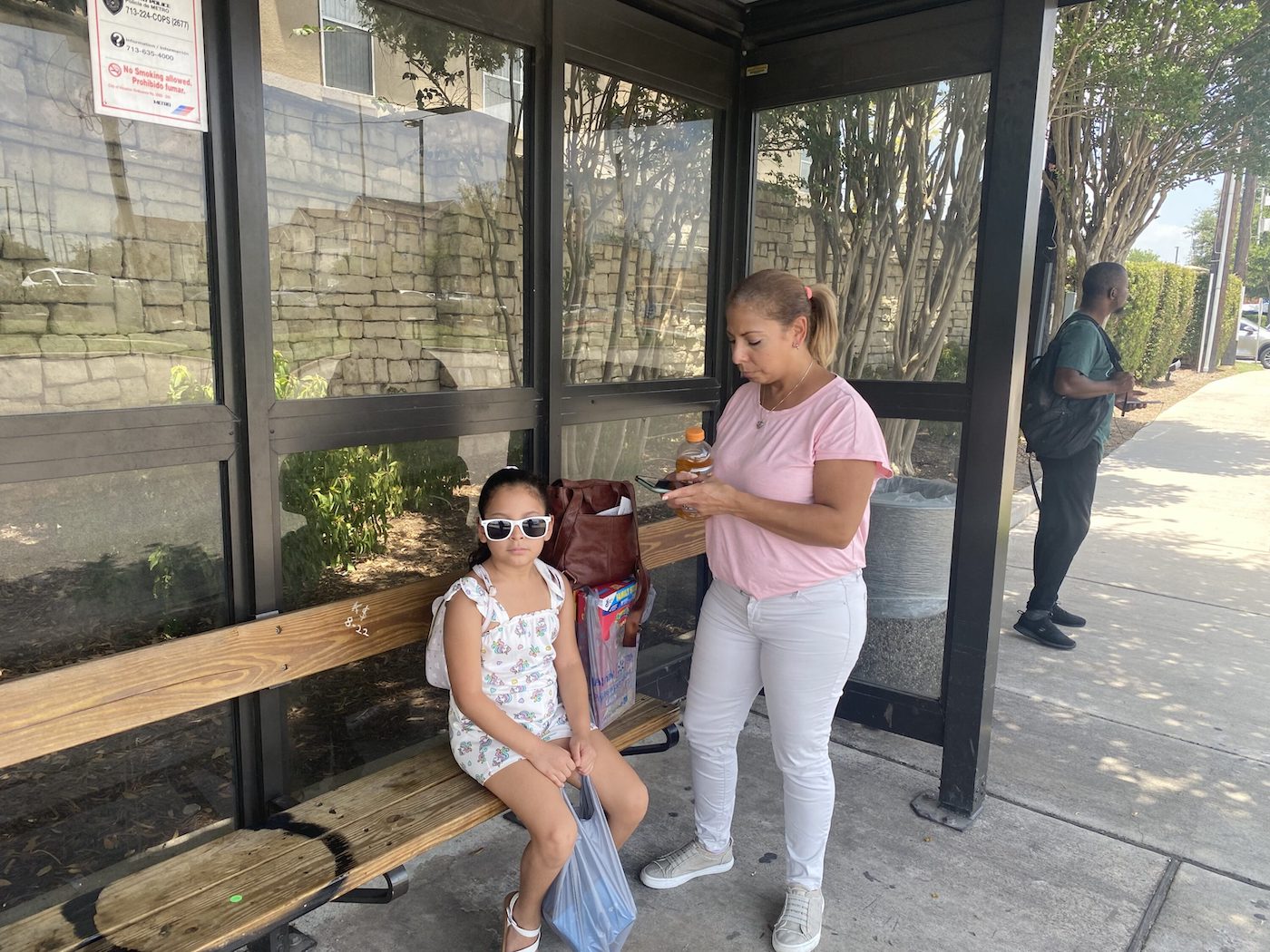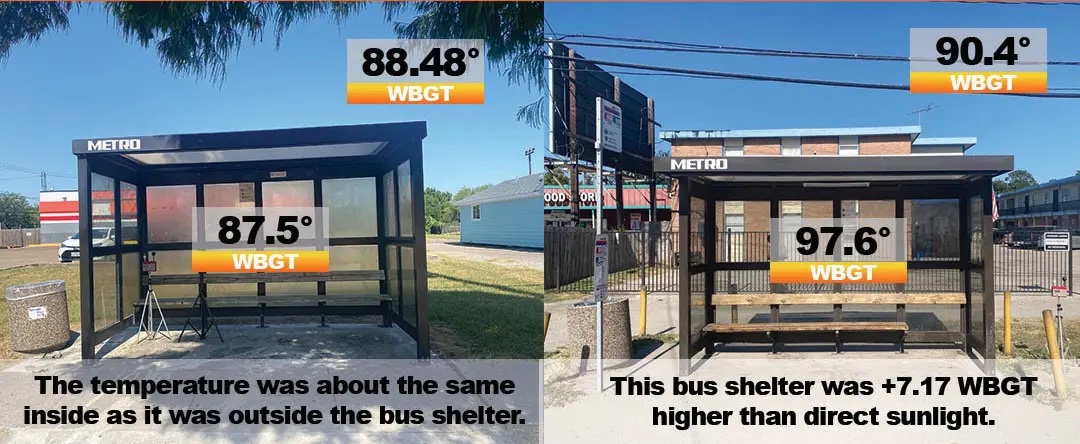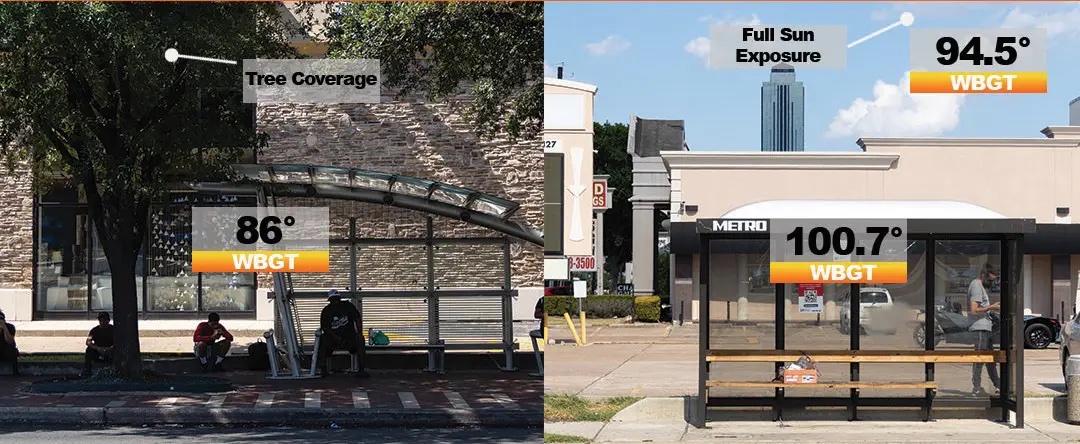Waiting for the Bus in Houston is Hot. And Dangerous.
10:35 minutes

 This article is part of The State of Science, a series featuring science stories from public radio stations across the United States. This story, by Sara Willa Ernst and Katie Watkins, was originally published by Houston Public Media.
This article is part of The State of Science, a series featuring science stories from public radio stations across the United States. This story, by Sara Willa Ernst and Katie Watkins, was originally published by Houston Public Media.
It was a hot summer day and Glory Medina and her daughter Jade, who was 3 at the time, were running a quick errand at the grocery store near their apartment in Gulfton. They had taken the bus and once they arrived, the two of them faced a giant unshaded parking lot, the black asphalt radiating heat into their faces as they walked across it.
The blast of AC felt cool as they entered the store, and Medina bent down to lift her daughter into the grocery cart. That’s when she noticed Jade’s face was red, almost purple.
“I got scared,” Medina said in Spanish, remembering that day four years ago.
Grabbing a water bottle from a fridge near the checkout lines, Medina quickly twisted off the cap and doused her daughter with cold relief.
“I just grabbed the bottle and poured it on top of her because she was as red as a tomato,” Medina said, adding that she paid for the water afterwards.
Her daughter was on the verge of heat illness. And Medina knew this because she too has suffered from heat illness multiple times. The worst, she said, was last summer when she collapsed at an intersection before crossing the street.
“You don’t think that can happen on such a short trip from your house,” she said. “But it does.”
A records request of 911 calls to The Houston Fire Department in June and July show at least 16 emergency calls were made from the bus or the bus stop for people experiencing “Temperature Related Problems.”
Read more of this investigation at Houston Public Media’s website.


Sara Willa Ernst is a health reporter at Houston Public Media in Houston, Texas.
Katie Watkins is an environment reporter with Houston Public Media in Houston, Texas.
IRA FLATOW: This is Science Friday. I’m Ira Flatow. And now it’s time to check in on the state of science.
[MUSIC PLAYING]
SPEAKER 1: This is KER–
SPEAKER 2: For WWNO–
SPEAKER 3: Saint Louis Public Radio–
SPEAKER 4: Iowa Public Radio News.
IRA FLATOW: Local science stories of national significance. Many cities across the country have climate action plans in place, ways to decrease citywide emissions and make a transition to clean energy. Houston, Texas is one of those cities. One of the ways Houston plans to cut emissions is by encouraging the use of public transit, like the city’s bus system.
But journalists from Houston Public Media report that Houston’s bus stops reached dangerously hot temperatures and that the existing bus shelters don’t keep people cool as they wait for the bus, making taking the bus not a very enticing alternative.
Joining me to talk about this are my guests, Sarah Willa Ernst, health reporter for Houston Public Media, Katie Watkins, environmental reporter for Houston Public Media. Welcome to Science Friday.
KATIE WATKINS: Thanks for having us.
SARAH WILLA ERNST: Hi, Ira.
IRA FLATOW: Katie, let’s start with you. Can you explain what Houston’s bus system is like? How big it is? Is it reliable?
KATIE WATKINS: Yeah, so Houston’s bus system is pretty big. It covers 1,300 square miles in the greater Houston area, and it has more than 9,000 bus stops, which were the focus of our investigation. In terms of reliability, it really depends on who you ask.
Many riders we spoke with said they do find the bus pretty reliable. They use an app to plan out their trip, and that way they can reduce the amount of time they’re waiting at a hot bus stop. But a lot of other riders we spoke with said a lot of times the bus is late, or the app will say it’s going to arrive at a certain time and then it just never shows up. And in those cases, people can end up waiting outside for a lot longer than they had planned.
IRA FLATOW: Sarah, let’s talk about who uses the buses in Houston. Is it a popular way to travel?
SARAH WILLA ERNST: So for those of you who haven’t been to Houston, Texas, it is absolutely a car-centric city. I mean, this is the oil and gas capital. And so you kind of have to go out of your way to see pedestrians and see transit riders if you’re just driving through town. It’s not a particularly ubiquitous form of transportation.
But the people who do take it, rely on it quite a bit. There are about four million rides for the month of June this year. And the people that take it, they take it pretty much every day. 70% take it five days a week. And those people also– the way that they get to the bus station is by pretty much walking or biking. So it seems like a lot of these people don’t have access to cars and public transit is the way that they get around.
IRA FLATOW: Katie, in your reporting, you wanted to know just how hot Houston’s bus stops are. Well, how hot were they?
KATIE WATKINS: Pretty hot. [LAUGHS] For context, we took measurements in a metric called Wet Bulb Globe Temperature. Experts say that better captures the impact of heat stress on the body, because, in addition to air temperature and humidity, it also measures solar radiation, so the heat from the sun. And with WBGT, once it gets over 90, it’s considered an extreme risk of heat illness. And that’s when experts recommend everyone take precautions if they’re outside.
And so we found that nearly 3/4 of our readings inside bus shelters were above that threshold, above 90 WBGT. And in some cases, they got as high as 103 degrees. And we also found that bus shelters were a bit inconsistent. When they provided shade, it was cooler than direct sunlight. But in some cases, about 16% of the time, we found that temperatures inside bus shelters were actually hotter than standing in direct sunlight.
We showed our results to Brian Stone. He’s the Director of the Urban Climate Lab at Georgia Tech.
BRIAN STONE: Well, that’s horrifying. It’s really not good. You should not be standing out there. So if you’re measuring north of 90, I don’t know of any chart that says you should be outside. You don’t have to be moving around as an elderly person with a heart condition to be in a danger zone at 90.
SARAH WILLA ERNST: Keep in mind, we did this pilot study in late July and early August, which are some of the hottest months of the year here in Houston. And we decided to focus on rush hour readings, so that we can capture it’s the hottest time of the day and it’s probably the time where most people are using the bus as well.
IRA FLATOW: Sarah, I know you spoke to people who ride the Houston bus system. What did they tell you?
SARAH WILLA ERNST: We heard that it was really, really hot. [LAUGHS] I mean, I think that is quite obvious by standing out there and anybody who’s used the public transit system. And it was definitely reflected in our temperature readings, too. It isn’t just waiting at the bus stop. But it’s also walking to the bus stop. It’s also the transfers that are involved as well. And all that time really adds up– being outside in the heat.
And we heard a range of how that affected people’s lives. Sometimes they would skip using the bus during really, really hot days. And then there were also some health impacts, too. We heard quite a few stories about, I would say, more mild health impacts, like experiencing migraines, headaches, skin irritation by being out in the sun too much. And then we heard some that were on the more moderate end.
We interviewed one woman who experienced what we think is heat syncope, a type of heat illness. And basically, she passed out while in transit. That happened to her a couple of times. And it also nearly happened to her daughter. One time she was at a grocery store after taking the bus and she saw her daughter’s face turn bright red like a tomato, almost purple, she said.
And in that moment, she was at around the checkout area. She grabbed some of the water bottles by those little mini fridges and just dowsed her daughter with that cold water. And it likely prevented her from experiencing more severe heat illness at that moment.
We also spoke to another woman. Her name is Juana Mendoza. And we caught her at the bus stop in a neighborhood called Gulfton.
JUANA MENDOZA: So it was too hot. I was so dizzy. Thank god, a guy give me some water. So I shared with my son.
IRA FLATOW: Do we know how many people have been hospitalized from waiting in hot bus stops?
SARAH WILLA ERNST: We don’t have any data on hospitalizations, but we do have 911 data. We submitted a records request to the Houston Fire Department. And in the months of June and July this year, we saw at least 16 calls from people at bus stops or on the bus for temperature-related problems. And I think it’s pretty safe to say that that is heat illness in the middle of summer as opposed to a different type of temperature-related problem.
But we are fairly sure that this is an undercount. At least 200 calls during that period of time, and these were calls at the bus stop or on the bus that were labeled under unconscious person or sick person. These types of descriptions that could be construed as heat illness.
And then there were also the people who don’t call 911. The woman that I mentioned earlier at the grocery store with her daughter, she didn’t call 911 during the multiple occasions that she or her daughter has experienced heat illness.
IRA FLATOW: That’s interesting. You mentioned before how the bus shelters can be hotter inside than standing outside in the sun. Katie, is there a type of bus shelter that is the best under extreme heat?
KATIE WATKINS: Yeah. Well, I’ll start by saying I guess what the hottest bus shelters all had in common in terms of design. And that was they all had Plexiglas-like material on three sides. And so our theory is that they were acting like mini greenhouses. And when the sun was shining directly inside, they were trapping the heat inside and making it hotter.
On the flip side, the bus shelters where we recorded the coolest temperatures had more of an open design. And they also had lush tree canopies that were providing shade as well.
IRA FLATOW: Hmm. And Sarah, let’s talk about how Houston has responded to this. Is there any sense that this issue will be addressed?
SARAH WILLA ERNST: Well, that’s our hope. We did send a description of our pilot study, our key findings to the public transit agency called Metro here. And they did not acknowledge our pilot study. They said it would not bear any significance, given that they didn’t know the type of device that we used and any other variables that might impact the study. Although, we offered to be as transparent as possible, and give them all our raw data and walk them through our data analysis.
We are trying to schedule interviews with people at the city of Houston, not just the transit agency. And that will actually be the subject of our next episode.
IRA FLATOW: Katie, speaking of solutions, what would you suggest? Or from your research, are there any possible solutions that could be implemented?
KATIE WATKINS: Yeah, so I sort of alluded to this earlier, but one source of shade that really stood out in our readings were trees. So temperatures in tree shade were always cooler than direct sunlight. We only had one reading that crossed into that extreme heat risk category. Tree shade was also twice as cool as bus shelter shade. On average, it was about 6 degrees cooler than direct sunlight.
And so one potential solution would be to plant trees near bus stops where there’s space to do so. And then when trees aren’t possible, there may be opportunities to look at alternative shade structures. So we also spoke to one group in Houston who’s working on a design for a trellis-like structure that could work in some of these smaller areas.
IRA FLATOW: Hmm. And when can listeners expect part two of this story coming out later this month, Sarah?
SARAH WILLA ERNST: Episode 3 of our podcast Hot Stops comes out on September 21. And that same day will be the second web story that publishes on our website houstonpublicmedia.org.
IRA FLATOW: And that’s about all the time we have for this segment. Thank you both for your work and for coming on Science Friday.
SARAH WILLA ERNST: Thank you.
KATIE WATKINS: Thanks for having us.
IRA FLATOW: Sarah Willa Ernst, health reporter for Houston Public Media. Katie Watkins, environmental reporter for Houston Public Media. And you can read more about this story on our website sciencefriday.com/hotstops.
Copyright © 2023 Science Friday Initiative. All rights reserved. Science Friday transcripts are produced on a tight deadline by 3Play Media. Fidelity to the original aired/published audio or video file might vary, and text might be updated or amended in the future. For the authoritative record of Science Friday’s programming, please visit the original aired/published recording. For terms of use and more information, visit our policies pages at http://www.sciencefriday.com/about/policies/
Kathleen Davis is a producer and fill-in host at Science Friday, which means she spends her weeks researching, writing, editing, and sometimes talking into a microphone. She’s always eager to talk about freshwater lakes and Coney Island diners.
Ira Flatow is the founder and host of Science Friday. His green thumb has revived many an office plant at death’s door.